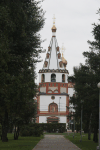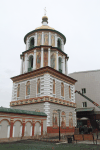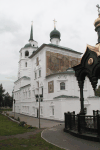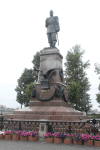
Epiphany Cathedral (built in 1718–1746). (629k)
From the Irkutsk entry in Wikipedia:
Irkutsk is a city and the administrative center of Irkutsk Oblast, Russia, and one of the largest cities in Siberia. Population: 587,891 (2010 Census); 593,604 (2002 Census); 622,301 (1989 Census).
In 1652, Ivan Pokhabov built a zimovyo (winter quarters) near the site of Irkutsk for gold trading and for the collection of fur taxes from the Buryats. In 1661, Yakov Pokhabov built an ostrog or small fort nearby. The ostrog gained official town rights from the government in 1686. The first road connection between Moscow and Irkutsk, the Siberian Road, was built in 1760, and benefited the town economy. Many new products, often imported from China via Kyakhta, became widely available in Irkutsk for the first time, including gold, diamonds, fur, wood, silk, and tea. In 1821, as part of the Mikhail Speransky's reforms, Siberia was administratively divided at the Yenisei River and Irkutsk became the seat of the Governor-General of East Siberia.
In the early 19th century, many Russian artists, officers, and nobles were sent into exile in Siberia for their part in the Decembrist revolt against Tsar Nicholas I. Irkutsk became the major center of intellectual and social life for these exiles, and much of the city's cultural heritage comes from them
By the end of the 19th century, there was one exiled man for every two locals. People of varying backgrounds, from members of the Decembrist uprising to Bolsheviks, had been in Irkutsk for many years and had greatly influenced the culture and development of the city.
In 1879, on July 4 and 6, the palace of the (then) Governor General, the principal administrative and municipal offices and many of the other public buildings were destroyed by fire, and the government archives, the library and the museum of the Siberian section of the Russian Geographical Society were completely ruined. Three-quarters of the city was destroyed, including approximately 4,000 houses. However, the city quickly rebounded, with electricity arriving in 1896, the first theater being built in 1897 and a major train station opened in 1898. The first train arrived in Irkutsk on August 16 of that year. By 1900, the city had earned the nickname of "The Paris of Siberia."
All pictures are © Dr. Günther Eichhorn, unless otherwise noted.








This page contains 8 pictures
Page last updated on Wed Jan 8 14:49:39 2020 (Mountain Standard Time)
Irkutsk on soaring.guenther-eichhorn.com